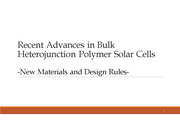

-
미리보기
소개
"Bulk hetero junction 고분자 태양전지의 동향"에 대한 내용입니다.목차
1. Introduction
2. New Materials and Design Rules for Efficient Light Harvesting
- Donor Polymers Developed at Early Stage
3. Recent Advances in Polymer Designs
-1. Effect of Polymer Backbone
-2. Influence of Side Chains
-3. Influence of the Substituents
-4. Other Effects to Be Considered
본문내용
Introduction
< Inorganic Solar Cells>
Solar energy
Inorganic materials: Crystalline Silicon, Copper Indium Germanium Selenide (CIGS), so on…
- High solar energy conversion efficiency
- Dominate photovoltaic (PV) technologies.
- High cost
- Environmental issues
< Thin Film Polymer Solar Cells (PSCs)>
- Low cost
- High throughput roll-to-roll production process
- Lightweight and flexible
< PCE(power conversion efficiency) of a solar cell>
- Open-circuit voltage (Voc)
- Short-circuit current density (Jsc)
- Fill factor (FF)
Divided by input power.
< Working Mechanism of Bulk Heterojunction (BHJ) PSC >
1. Light absorption and generation
- Highly localized, tightly bound Frenkel excitons.
2. Exciton diffusion to the donor- acceptor interface
3. Exciton dissociation at the interface
- First, creating charge transfer (CT) states or polaron pairs.
- Then, CT states dissociate into free charge carriers.
4. Charge transport and collection
참고자료
· 없음태그
-
자료후기
-
자주묻는질문의 답변을 확인해 주세요

꼭 알아주세요
-
자료의 정보 및 내용의 진실성에 대하여 해피캠퍼스는 보증하지 않으며, 해당 정보 및 게시물 저작권과 기타 법적 책임은 자료 등록자에게 있습니다.
자료 및 게시물 내용의 불법적 이용, 무단 전재∙배포는 금지되어 있습니다.
저작권침해, 명예훼손 등 분쟁 요소 발견 시 고객센터의 저작권침해 신고센터를 이용해 주시기 바랍니다. -
해피캠퍼스는 구매자와 판매자 모두가 만족하는 서비스가 되도록 노력하고 있으며, 아래의 4가지 자료환불 조건을 꼭 확인해주시기 바랍니다.
파일오류 중복자료 저작권 없음 설명과 실제 내용 불일치 파일의 다운로드가 제대로 되지 않거나 파일형식에 맞는 프로그램으로 정상 작동하지 않는 경우 다른 자료와 70% 이상 내용이 일치하는 경우 (중복임을 확인할 수 있는 근거 필요함) 인터넷의 다른 사이트, 연구기관, 학교, 서적 등의 자료를 도용한 경우 자료의 설명과 실제 자료의 내용이 일치하지 않는 경우
찾으시던 자료가 아닌가요?
지금 보는 자료와 연관되어 있어요!
문서 초안을 생성해주는 EasyAI




